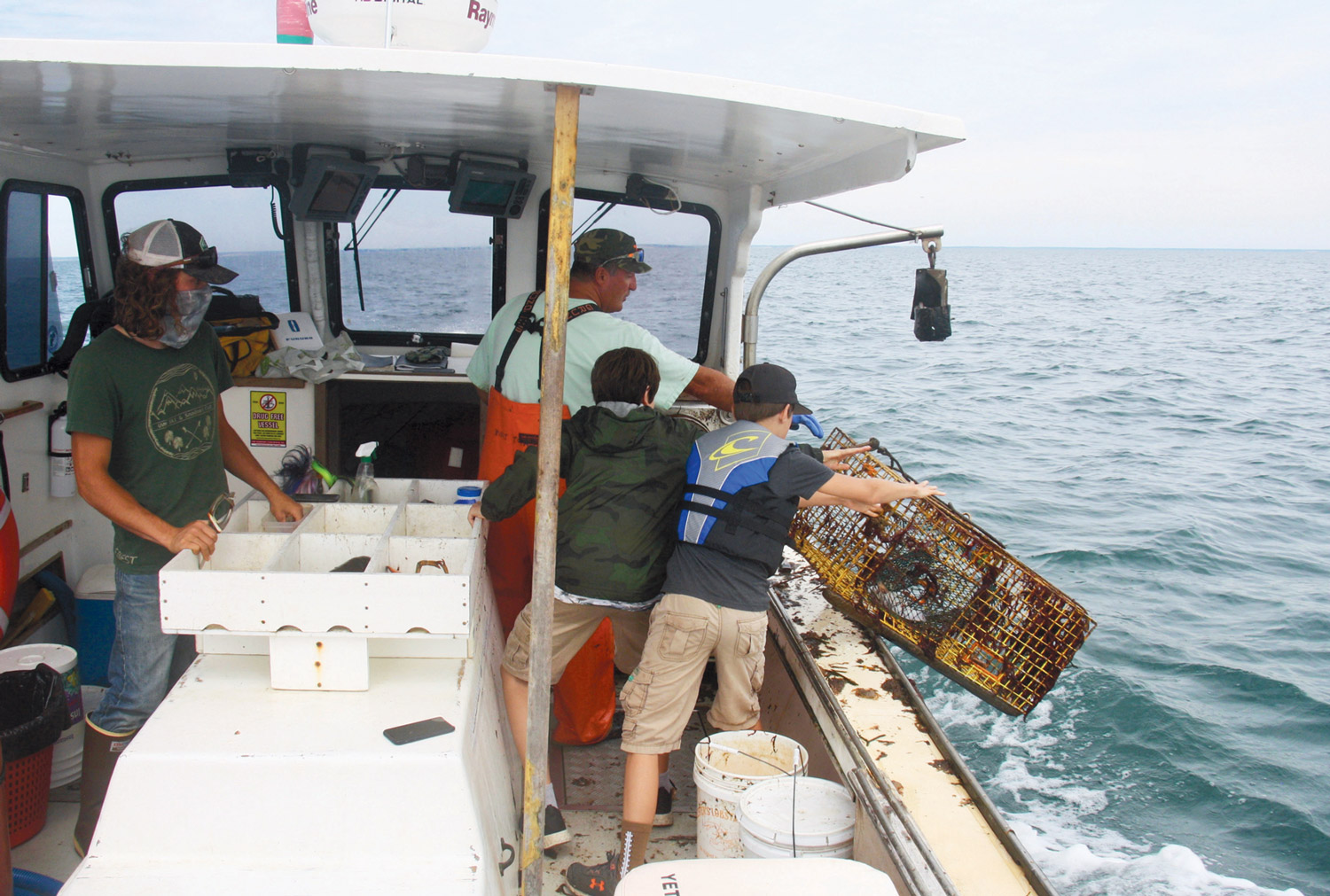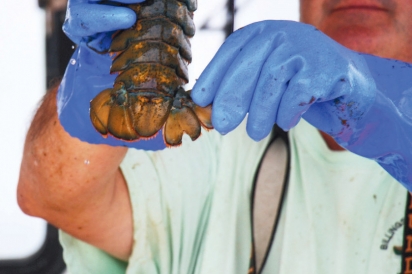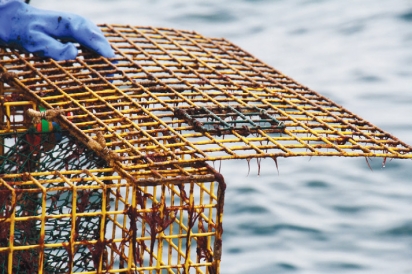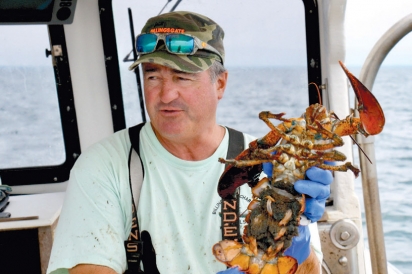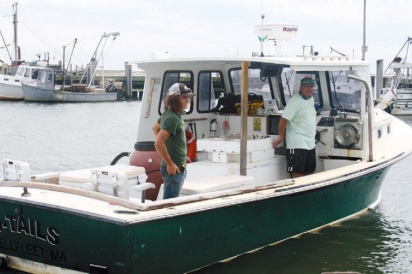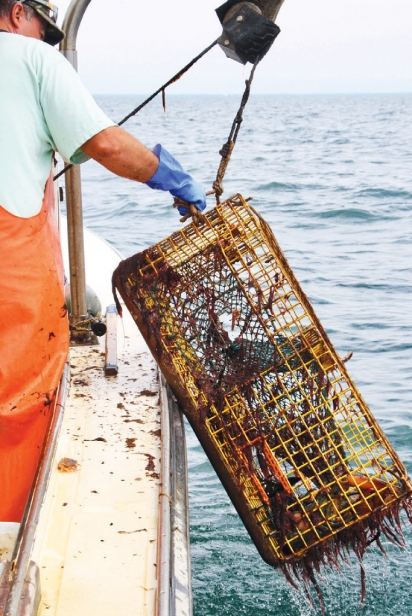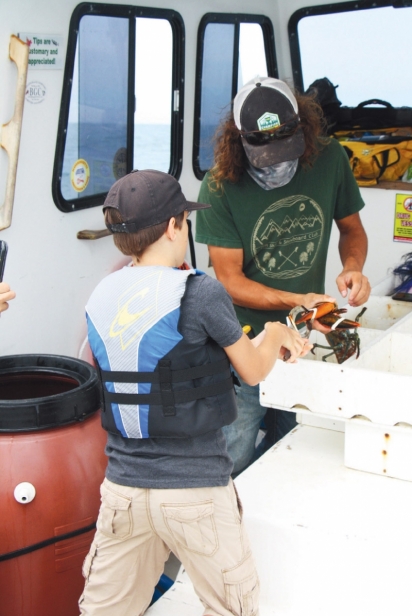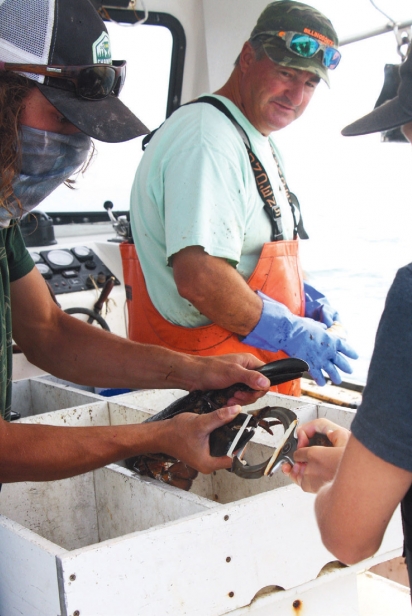A Crustacean Education It’s all in the D-Tails
The lessons began even before the engines of the lobster boat D-Tails ramped up to full throttle as she slowly headed out of Wellfleet harbor. Captain Dave Stamatis points off the starboard side in the direction of Mayo Beach to the north. “That’s where the Mercantile Wharf once stood,” he explains. “You can still see the pilings at low tide.” Stamatis goes on to tell the story of how Lorenzo Dow Baker bought the wharf in 1885 and built the Chequesset Inn on its pilings. It was the first such hotel in the area that put the Town of Wellfleet on the map as a getaway destination. A stretch of particularly nasty weather in the winter of 1934 caused ice floes to enter Wellfleet harbor, severely damaging the pier and partially collapsing the inn. It’s at this moment that I realized that the three-hour trip aboard a working lobster boat to learn about lobsters was going to be so much more.
Lobstering has been in Dave’s blood since working with his older brother Dan when they were young, when the pecking order of siblings was never clearer. “The little brother pulls up all the pots,” he laughs. In 2011, “recreational” turned “professional” as the Stamatis brothers pooled their resources and bought a boat. Dave got his license and became a commercial lobsterman when he launched Billingsgate Charters. His goal was to establish a viable business when the day came to retire from public service. Stamatis spent 32 years on the Reading police force, retiring as a lieutenant in 2017. Then he and his wife, Donna, made the move full time to the family vacation home he grew up enjoying in Wellfleet. For Dave, retirement wasn’t going to be all hammocks and beach chairs. No, he was already going in another, more exhausting direction.
“What’s the difference between these two pieces of land?” Dave asks the group of would-be greenhorn lobstermen as we continue out to Cape Cod Bay. Off the port side, the heavily developed coastline of Indian Point. To starboard, the undisturbed expanse of Great Island. “Houses?” was the less than confident response offered. “That’s right, Great Island is part of the Cape Cod National Seashore,” Stamatis confirms with the story of how it came to pass in August of 1961 after President Kennedy signed a bill establishing a sanctuary (for both wildlife and humans alike) that today encompasses over 43,000 acres.
As a commercial lobsterman, Stamatis tends 800 lobster pots from Wellfleet to Provincetown in Cape Cod Bay. In addition, D-Tails is available for sport fishing charters for anglers or combination charters of both fishing and lobstering. For those times when there are no charters booked, he’ll pull 150 pots in a day to check for lobsters and replenish the bait. One look at the calendar on his website, (billingsgatecharters.com) shows those “open” dates to be few and far between throughout the season. “The combo or lobster charters are at least ninety-five percent of all the charters we do,” Dave proclaims. “Everybody has been fishing, but how many people can say they’ve been on a lobster boat?” And since everyone receives a lobster at the end of the trip, bass and blues be damned! Bring on the lobsters! But first…
We’ve just made our way past Jeremy Point and Stamatis draws our attention to a line of rocks barely visible above the incoming tide. “That’s all that remains visible of Billingsgate Island,” He explains. “Before it washed away, it was home to a colony of fishermen who would keep their catch alive in fish wells, wait for the price to be right and sail it down to New York to sell.” The tale of Billingsgate Island is a fascinating one. As the erosion of the island became inevitable, many of the homes were floated over (some in pieces) to be relocated around the outer Cape. Many are still standing, including one that is home to the Wicked Oyster restaurant on Main Street in Wellfleet.
As we approach the first of the 20 pots to be pulled on this trip, the captain explains the process. “We come at the pots against the tide and the wind.” The depth of the pots ranges from 30 to 130 feet in the bay. “Lobsters like fifty-five degrees,” he declares. The lobsters will keep moving as the summer heat warms the water. Dave leans out over the gunwale and snags the red and green buoy. Not just for his own recognition, the individual color schemes let other lobstermen know to whom these traps belong. Further, commercial lobstermen need to display one of their buoys in a very visible location aboard the boat for easy recognition from afar. This is to make it obvious to all, including officials who perform periodic inspections, that a boat is hauling their own pots and not someone else’s. Dave attaches his to the antenna on the roof. He wraps the freshly-snagged line around a pulley and feeds it through a power winch that does the lifting of the 70-pound trap. Dave proudly points to the pulley. “A bit of Yankee ingenuity!” he states. He’s taken a piece of an old moped tire and fastened it to the pulley to act as makeshift squeegee of sorts to remove the excess seaweed and other debris that collects on the line.
In moments, the trap is at the surface. Stamatis hauls it aboard and breaks down the terminology. The trap has two “rooms:” the kitchen and the parlor. The kitchen holds the bait, and the parlor holds the lobsters who have tried to make their escape but took a wrong turn. Videos have shown that there are plenty of lobsters who manage to get in, dine on the bait and successfully find their way out. What makes the lobster fishery such a remarkable story of sustainability is the lengths to which the professionals will go to ensure the species survive.
One example is visible on the trap. A small square of coated wire is tied to the trap with simple twine. In the event that the trap becomes separated from its buoy, it becomes what’s called a “ghost trap.” Ghost traps are abandoned traps that can continue to collect lobsters for months or years. This square “escape vent” is installed to provide the lobsters an exit when the twine holding it in place erodes away. Other steps are taken to protect other species in the bay. The buoy is attached with weak links that will break away if large animals come into contact with it. The top two thirds of the line itself needs to be “sinking line;” rope that is heavier than the water to prevent it from floating on the surface and further creating entanglement possibilities for passing fish or whales.
Another area of collaborative effort by the fishermen is “V-notching.” When a commercial fisherman comes across a pregnant female (the tens of thousands of eggs on her underside is a dead giveaway), they need to cut a v-shaped notch in the second flipper from the right as seen from the top. Any lobster caught with a “V” notched into her flipper is off limits to commercial lobstermen. It protects a known breeder from capture, and helps ensure the fishery remain sustainable. Lobsters have exoskeletons, and need to molt and shed their shells to grow. This “V” will take several molts to work its way out, allowing the lobster to survive throughout her reproductive years. This practice started in Maine in the early 1900s. Dave examines the lobster to determine its legality. He measures the carapace (main body shell) for the proper length. Too small or too big and it’s back to the briny deep. He also looks for a “V” or eggs. As he says, “No eggs, no ‘V,’ she’s coming with me!” which is much better than his other refrain, “If there are eggs or a ‘V,’ it’s back to the sea.” He repeatedly tosses back a number of females during the trip, notching several himself.
The collective effort to protect the species doesn’t always translate into an “all-for-one, one-for-all” kind of teamwork in the bay. Lobstering is a job that needs constant maintenance and upkeep of gear. “You’ve got to keep up and check your pots, or they [other lobstermen] will check them for you,” Dave laughs. Then there’s the issue of territoriality. In the case of trawling lobster boats that haul up entire strings of pots which are tied together, it’s not unheard of that another boat’s gear may get swept up as well. Such cases result in the trap being emptied of its contents and the line being cut and retied to send a message of warning. Some boats won’t even bother retying the line.
The legal lobster’s claws are quickly banded. The two distinctive claws each play a vital role for the lobster. The “crusher” (the one that looks like it has a set of molars on it) is for cracking open shells of a potential meal. The “pincher” is used for tearing the meat found inside. Stamatis displays the differences between the male and female lobsters. The most obvious is the size of the crusher claw — it’s much bigger on the males. Anyone in the group can get involved and help Dave’s mate Alex Eldridge apply the rubber bands to the claws and dump the lobsters into the holding tank on board. Dave rebaits the trap with a dead skate that was bycatch from another vessel. “Lobsters are scared of everything,” Stamatis chuckles as he places the skate upside down in the trap to further put the quarry at ease. Apparently just being dead isn’t enough for these ‘fraidy fish.
“What color is the lobster’s blood?” He poses to the party. “Blue!” offers a group member. “Good guess, but it’s actually clear. You know that white substance you see in the shells and on the meat when they come out of the pot?” Heads nod in unison. “Well, that’s the blood after it’s been cooked,” he reveals. Captain Dave enjoys the educational aspect of these trips. It shows the amount of work that goes into the lobster arriving on your plate. “People don’t think about how the lobster got there,” he imparts. It’s an eye-opening experience for nearly everyone. “They can see why it’s so expensive,” he grins. Not that it was always that way. “Lobster was used as fertilizer and was served to the prisoners of the Massachusetts penal system because it was so cheap,” he says.
The pots won’t come out of the water for the winter until mid-November. Until then, there are ample opportunities to experience something few people have done. Try walking in the boots of a Cape Cod lobsterman. See what it takes. Learn what they are up against and how they survive. Stamatis is a man who loves his work, and that passion comes through in the excitement in his voice as he teaches others all about it. He may have left the police ranks, but he continues to provide a much-needed public service. A few hours with Captain Dave Stamatis, and you’ll have a richer sense of the history of this beautiful area and learn a bit of biology as well. You’ll come away with a newfound appreciation for those working the sea, the wildlife within it…and a lobster for your pot!
Billingsgate Charters
Billingsgatecharters.com
(781) 706-0145


